Did you know the ocean and sea covers 7/10 of the earth’s surface? Post World War II immense changes took place in the way businesses shipped products; not to mention the design and construction of ships. Passenger ships fell and bulk carriers rose. This was due partly because of the Suez Canal closing in 1956. Ships now go around Cape of Good Hope, South Africa.
Bulk carriers were purposely designed for rapid unloading and loading of their specific cargo; ore, grain, cars, etc. Another type of “bulk” carrier is the container ship. These ships use metal containers to pack the cargo to load and unload at dockside. Usually, the metal containers are the same size. This helps transporting cargo from shifting in bad storms and heavy weather. This method helped decrease the possibility of ships sinking at sea; which was a known problem.
War experience in landing tanks also paid off; especially landing on enemy coasts. They used a new method called roll-on, roll-off ferries (RORO). Prior to using RORO method, cranes lifted off cars at the docks with a 4-point chain bridle. Then they lowered the cars into the holding section of the ferry. The first RORO ferries drove cars onboard via a ramp then through the stern doors.
Did you also know without the use of ships our standards of living would be radically different? Read the rest of this entry »
June 25th, 2015 in
Brunswick,
Colonel's Island,
Georgia,
Interesting People,
International Seafarer Center (ISC),
Organizations,
Places of Interest,
Seafarers | tags:
Brunswick,
car ships,
Colonel's Island,
Georgia,
International Seafarer Center,
ISC,
Seafarers |
No Comments
I recently ran across an article titled:
Hope Remains Afloat through Dragon Boating where Janice McAuley talks about what it’s like to lose a year of her life due to cancer. After finishing her treatment she had to find a way to transition back to life. But life post-cancer isn’t what it used to be, so many [people] turn to boating.
This was true in my case as well. There’s something about the whole experience of being on a boat that is calming. It doesn’t matter if it’s on the ocean or a lake. For me, the pace of sailing was the answer. A far cry from the hectic life I led before cancer. For Janice, it’s dragon boating.
To read more about Janice’s story click here:
http://www.comoxvalleyrecord.com/news/301467251.html
If you know any organizations that offer boating days/specials for cancer patients let us know.
This article was published in Spring 2015 Nor’Easter for TONE (Tartan Owners Northeast). Inc.
for previous article go here:
Suddenly in Command: First Aid
by Robin G. Coles
In my last article I mentioned Luke had a heart attack. Dani got stuck at the helm; “Suddenly in
Command”. Fortunately for her, Luke was able to give her directions while he was lying down in the
cockpit. But, what if some other medical emergency happened?
Emergencies come in different shapes and sizes. Some are man-made. Others are acts of nature. If
they happen at sea, they will need quick action taken. In addition to getting hit by the boom, falling
overboard, slipping on the deck, and carbon monoxide poisoning can become a major trauma; unless someone on board knows exactly what to do.
Education and planning can help you feel more confident. The best way to get this confidence is to
take the American Red Cross or US Sailing courses; CPR, First Aid and AED (Automated External
Defibrillator).
http://www.ussailing.org/racing/offshore-bigboats/senior-first-aid-certification/
Before you leave the dock, here are a few things you can do to prepare yourself for an emergency.
1. Check your VHF Radio to make sure it’s working. It should have a red DSC (Digital Selective
Calling) button on it. And its MMSI number is registered. (Maritime Mobile Service Identity
Number) If not, you can register it here:
http://www.usps.org/php/mmsi/home.php (United States Power Squadron)
2. Check your first aid kit and make sure you have supplies in it such as: band-aids, ace bandages,
aspirin, hot and cold packs, alcohol, antacids. An up-to-date first aid book also.
3. Have your passengers fill out a form with their medical history on it. This will tell you who their
physicians are. Any medications they’re taking. Types of allergies they have. And who is their
emergency contact. Then take everyone’s forms and put them all together in one spot where everyone
on board can find them. A good place might be the chart table.
You might also ask everyone to enter a name in their cell phone under “ICOE” (in case of emergency).
This will come in handy when you pass this information onto either the USCG or whoever rescues you.
At sea if you encounter a medical emergency you’ll need to: Assess the Scene and Alert others on board.
You’ll also need to quickly check your surroundings to see if you can get back to shore. Complete a
secondary survey for injuries. Ask about symptoms and observe signs for something wrong or out of the
ordinary. As soon as you can, start a log of what happened, symptoms and treatments you provided.
This should go with the person once help arrives.
The Good Samaritan law protects you if you don’t go beyond the scope of your training. To prevent a
lawsuit, make sure you only advise and act upon what you’ve learned. If a person is unconscious and
not breathing, you’ll have to assume permission is implied. Make sure you explain everything you’re
doing each step of the way and ask for confirmation. You’ll also want to state that you’re going to call the next level of care.
About Robin:
Robin is a published author, passionate marine enthusiast and sailor who has interviewed countless
industry experts as well as visited, interviewed personnel at, written about, and photographed
hundreds of marine ports in the US and abroad.
Robin also works with businesses to help them tell their stories. Articles, customer success stories, and
videos are just a few ways she helps her clients. Her current projects include videos about Boat Safety. If you’d like to get involved in these, let Robin know.
April 27th, 2015 in
Boat Safety,
Boaters,
Equipment,
Organizations,
Recreational boats,
Safety,
Suddenly in Command,
TONE | tags:
Boat Safety,
Boating,
emergency,
engines,
Nautical Lifestyle,
Sail Boats,
sailing,
suddenly in command,
Tartan,
thenauticallifestyle,
Tone |
No Comments
For four years now, Art Wynwood has held their winter art show the same time as the Miami Boat Show. This year they had 66 exhibitors. According to Grela Oriahuela everyone really brought their A game. “I’m really thrilled with the work that everyone’s brought,” says Oriahuela. “There’s both local and international galleries here. We did some special projects with local galleries in a way to express how Miami is making art and doing beautiful things in the art community year round. This includes a Solo Miami Project with Fredric Snitzer, Emerson Dorsh, Primary Projects, Anthony Spinello, and Gucci Vuitton all participating with a local artist.”
In the photographs below you’ll see everything from a crocheted bicycle, urinal made of white buttons, an old victrola, woman’s face made out of wine bottle corks, pets enjoying the show while being pushed in a stroller and nude art with banana peels.

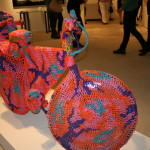

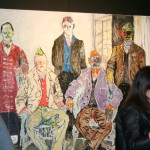


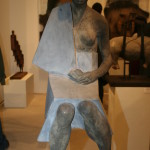


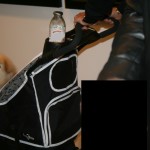
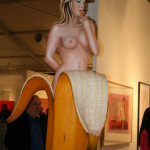

Four years ago this art show started with 48 exhibitors. Last year they had 30k people walk through the show. This year they anticipated 35k people. Not bad for an art show still in its infancy. It is now considered the most important art fair of the winter season in Miami. It runs alongside the Miami Boat Show and the Coconut Grove Festival. Plus it’s a holiday weekend.
Whether you’re into art or not sure how to appreciate it, there’s something at this show for everyone. “It’s modern, contemporary and emerging, ” says Oriahuela. “We do something other art fairs don’t do which is exhibit a lot of work that’s inspired by the street art movement.” Because it takes place over the weekend you can take your time and go back again. You can get to know both the dealers and artists because a lot of them come and spend the weekend as well. It’s an art fair for high end collectors and art enthusiast alike. During the show you’ll find galleries making multi-million dollar deals, galleries that are emerging, and people who have never bought art work before. This is the best way to get introduced to art. It’s not as intimidating as one would think and it’s a great place for people to buy their first art piece.
It’s also an awesome place for the kids. They have a kids center available to allow their parents the ability to take a nice leisurely walk around. The kids are being watched by the Miami children’s museum and they do art activities with them. Kids learn about art and are taken on little tours around the exhibits.
Art Wynwood is worth taking time out of your busy schedule. As mentioned above, there is a whole range of artwork for you to enjoy. For more information or to get tickets for next year go to:
http://artwynwood.com
March 10th, 2015 in
Boat Shows,
Boaters,
Florida,
Interesting People,
Miami,
People I've Met,
Places of Interest,
Strictly Sail Miami | tags:
art shows,
exhibits,
Florida,
Nautical,
Nautical Lifestyle,
thenauticallifestyle,
Wynwood |
No Comments
 I met George Kaiser back in 2007 at an event in Winthrop, MA that I was photographing. I learned he was a model ship builder and asked for his card. A few months ago I contacted George to see if he was was still building model ships and if so, could I interview him. Since then, I’ve had the pleasure of spending a few hours with him learning about his adventures into model ship building. Here is the interview we did along with a few photos of his models and workspace that are referred to in the interview. Sadly, George passed away February 16, 2015.
I met George Kaiser back in 2007 at an event in Winthrop, MA that I was photographing. I learned he was a model ship builder and asked for his card. A few months ago I contacted George to see if he was was still building model ships and if so, could I interview him. Since then, I’ve had the pleasure of spending a few hours with him learning about his adventures into model ship building. Here is the interview we did along with a few photos of his models and workspace that are referred to in the interview. Sadly, George passed away February 16, 2015.
Click on Audio Icon to hear interview  |





WELL DONE….I LOVE it !
What a fascinating life journey Mr. Kaiser has had and is having at a
young 87. From the Depression, through WW II to the current. He is so modest
about his artistic skills and you really captured his charm in this
interview. I will go see his model at the Constitution Museum. Your photos are great
and makes me yearn to own one.
Thank you for sharing this, it made my day.
Hope to see you soon.Sally Higbee
via email |



















